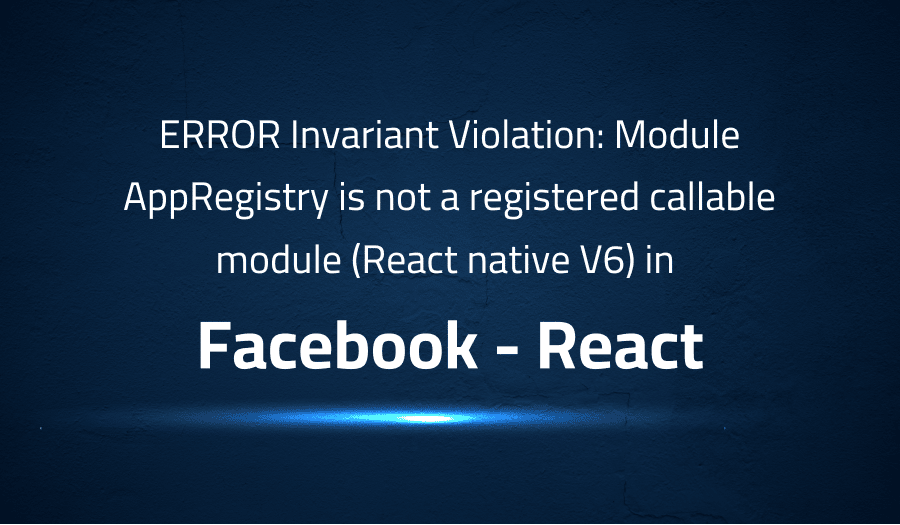

ERROR Invariant Violation: Module AppRegistry is not a registered callable module (React native V6) in Facebook React
Explanation of the problem
The application is encountering a TypeError and an Invariant Violation when attempting to run the code. The TypeError states that “undefined is not an object (evaluating ‘Object.keys(o)’)” and the Invariant Violation states that “Module AppRegistry is not a registered callable module (calling runApplication).” The error message suggests that the error may be caused by an incorrect file path or a corrupt JS bundle. This error occurs when adding StackNavigator code to the App.js file. The version of React Native being used is 0.67. The error is reproducible by adding StackNavigator code to the App.js file. The package.json and App.js files have been provided as examples.
Troubleshooting with the Lightrun Developer Observability Platform
Getting a sense of what’s actually happening inside a live application is a frustrating experience, one that relies mostly on querying and observing whatever logs were written during development.
Lightrun is a Developer Observability Platform, allowing developers to add telemetry to live applications in real-time, on-demand, and right from the IDE.
- Instantly add logs to, set metrics in, and take snapshots of live applications
- Insights delivered straight to your IDE or CLI
- Works where you do: dev, QA, staging, CI/CD, and production
Start for free today
Problem solution for ERROR Invariant Violation: Module AppRegistry is not a registered callable module (React native V6) in Facebook React
The issue of “undefined is not an object (evaluating ‘Object.keys(o)’)” and “Module AppRegistry is not a registered callable module (calling runApplication)” when adding StackNavigator code to the App.js file can have several causes. One of the most common causes is related to changes made to the node_modules folder, such as installing new libraries. This can lead to inconsistencies or conflicts within the dependencies, causing the application to fail.
One solution to this issue is to remove the cache and reinstall the dependencies using either yarn or npm. This can be done by running the command “npx react-native-clean-project” followed by “yarn install” or “npm install”.
$ npx react-native-clean-project
$ yarn installAnother solution that has been suggested is to add the line “import * as React from ‘react'” in the file where the navigation is added. This is because the error message “Module AppRegistry is not a registered callable module (calling runApplication)” suggests that there is an issue with the React import. By adding this line, you ensure that React is being imported correctly, which can resolve the issue.
import * as React from 'react';It is important to note that the exact cause of the issue may vary depending on the specific implementation and environment of the application, so it may be necessary to try multiple solutions to find the one that works best in your case.
Other popular problems with React
Problem: Virtual DOM performance issues
One of the most common problems with React is related to performance issues with the virtual DOM. The virtual DOM is a mechanism that React uses to update the view in response to changes in the underlying data. When the state of a component changes, React will first update the virtual DOM, and then update the actual DOM. This process can be slow, particularly if the component has a large number of child elements.
Solution:
To solve this problem, developers can use techniques such as shouldComponentUpdate, which allows components to control when they should re-render, or use the React.memo higher-order component, which only re-renders a component when its props change. Additionally, developers can use the React DevTools extension to identify and optimize components that are causing performance bottlenecks.
Problem: Managing state and props
Another common problem with React is related to managing state and props. React components can have both state and props, which are used to store and pass data between components. However, when a large number of components need to share and update data, it can become difficult to manage and maintain the flow of data.
Solution:
To solve this problem, developers can use a centralized state management library such as Redux or MobX. These libraries allow developers to store all of the application’s state in a single place, and provide a mechanism for updating and sharing that state across all components. Additionally, developers can use the useContext and useReducer hooks to manage state within a component tree.
Problem: Handling Forms
React forms can also be a source of pain for developers, as they require a lot of boilerplate code to handle changes and validation. Forms can be tricky to handle because they often involve multiple inputs, which need to be controlled and updated correctly.
Solution:
To solve this problem, developers can use libraries such as Formik and react-hook-form to handle forms in React. These libraries provide simple APIs for controlling form inputs and handling validation. Additionally, developers can use the useState and useEffect hooks to handle form input changes and validation manually.
A brief introduction to React
React is a JavaScript library for building user interfaces. It was developed by Facebook and is now maintained by a community of developers. React allows developers to build reusable UI components, which can be composed to create complex user interfaces. React uses a virtual DOM (Document Object Model) to improve performance by limiting the amount of changes that need to be made to the actual DOM. The virtual DOM is a lightweight representation of the actual DOM and it allows React to compare the current state of the virtual DOM with the previous state, and make only the necessary changes to the actual DOM.
React follows a component-based architecture, where the user interface is broken down into small, self-contained components that can be easily reused and composed to create more complex UI. React components can have both state and props, which are used to store and pass data between components. React also provides a mechanism for handling events, such as user clicks, through the use of event handlers. React also provides a set of lifecycle methods that developers can use to control when a component is created, updated, and destroyed. This allows developers to control the behavior of their components and optimize performance.
Most popular use cases for React
- Building reusable UI components React allows developers to build reusable UI components that can be composed to create complex user interfaces. Each component is self-contained and can manage its own state and props. This allows developers to easily reuse and maintain their code.
- Dynamic User Interfaces React uses a virtual DOM to improve performance by limiting the amount of changes that need to be made to the actual DOM. This allows developers to build dynamic user interfaces that can efficiently update in response to changes in the underlying data.
- Building complex web applications React can be used to build complex web applications that require efficient updating of dynamic data. React also provides a set of lifecycle methods that developers can use to control when a component is created, updated, and destroyed. This allows developers to control the behavior of their components and optimize performance.
class Counter extends React.Component {
constructor(props) {
super(props);
this.state = { count: 0 };
}
handleClick = () => {
this.setState({ count: this.state.count + 1 });
}
render() {
return (
<div>
<p>Count: {this.state.count}</p>
<button onClick={this.handleClick}>
Increment
</button>
</div>
);
}
}
It’s Really not that Complicated.
You can actually understand what’s going on inside your live applications.




